1996 CHEVROLET CORVETTE stop start
[x] Cancel search: stop startPage 51 of 386

Downloaded from www.Manualslib.com manuals search engine Matching Transmitter($) To Your Vehicle
Each key chain transmitter is coded to prevent another
transmitter from unlocking your vehicle. If a transmitter
is lost or stolen, a replacement can be purchased through
your dealer. Remember to bring any remaining
transmitters with you when you go to your dealer. When
the dealer matches the replacement transmitter to your
vehicle, any remaining transmitters must
also be
matched. Once the new transmitter is coded, the lost
transmitter will not unlock your vehicle. Each vehicle
can have only three transmitters matched to it.
To match transmitters to your vehicle:
1. Move all transmitters out of range.
2. Turn the ignition key on.
3. Push TRIP OD0 on the Driver Information Center
twice.
4. Within five seconds, press and hold FUEL INFO
until the PASSIVE KEYLESS ENTRY light
comes on.
5. Turn the ignition off, but leave the key in the
ignition. The PASSIVE KEYLESS ENTRY light
should begin to flash to show the system is in
programming mode.
6. Bring one transmitter into range. The light will stop
flashing and stay on to show that the code is stored.
7. Move the transmitter out of range. The light should
start flashing again.
8. Repeat Steps 6 and 7 with each additional
The programming mode will shut
off if
transmitter.
0 You
don’t program any transmitters for two minutes.
0 You take the key out of the ignition or turn the
ignition on.
0 You have programmed three transmitters.
Battery Replacement
Under normal use, the battery in your key chain
transmitter should last about
18 months.
You can tell the battery is weak if the transmitter won’t
work at the normal range in any location. If you have to
get close to your vehicle before the transmitter works,
it’s probably time to change the battery.
Page 56 of 386
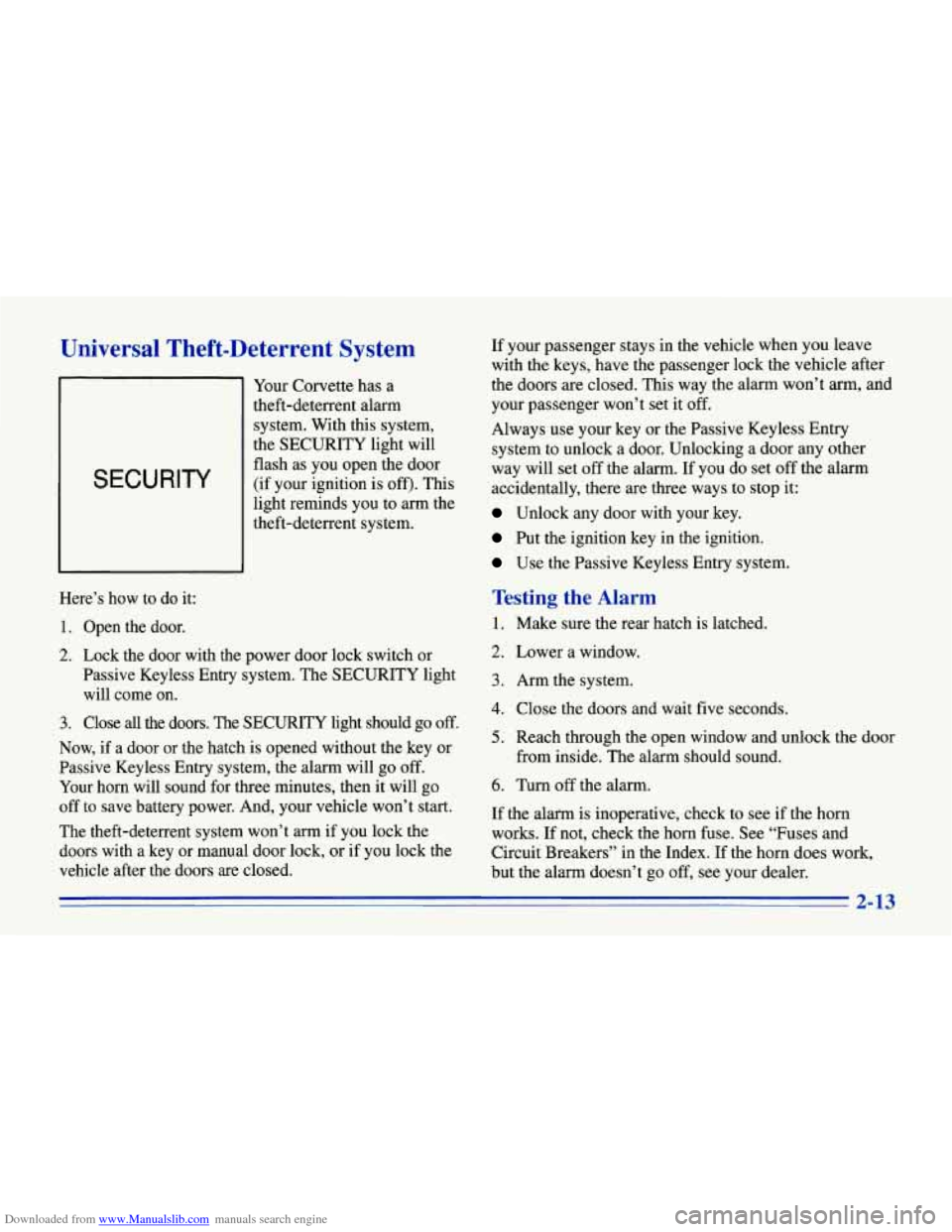
Downloaded from www.Manualslib.com manuals search engine Universal Theft-Deterrent System
SECURITY
Your Corvette has a
theft-deterrent alarm system. With this system,
the SECURITY light will
flash as you open the door
(if your ignition is off). This
light reminds you to arm the
theft-deterrent system.
Here’s how to do it:
1. Open the door.
2. Lock the door with the power door lock switch or
Passive Keyless Entry system. The SECURITY light
will come
on.
3. Close all the doors. The SECURITY light should go off.
Now, if a door or the hatch is opened without the key or
Passive Keyless Entry system, the alarm will
go off.
Your horn will sound for three minutes, then it will go
off to save battery power. And, your vehicle won’t start.
The theft-deterrent system won’t arm
if you lock the
doors with a key or manual door lock, or
if you lock the
vehicle after the doors are closed. If
your passenger stays in the vehcle when you leave
with the keys, have the passenger lock
the vehicle after
the doors
are closed. This way the alarm won’t arm, and
your passenger won’t set it off.
Always use your key
or the Passive Keyless Entry
system to unlock a door. Unlocking a door any other
way will set
off the alarm. If you do set off the alarm
accidentally, there
are three ways to stop it:
Unlock any door with your key.
Put the ignition key in the ignition.
Use the Passive Keyless Entry system.
Testing the Alarm
1.
2.
3.
4.
5.
6.
Make sure the rear hatch is latched.
Lower a window.
Arm the system.
Close the doors and wait five seconds.
Reach through the open window and unlock the door
from inside. The alarm should sound.
Turn
off the alarm.
If the alam is inoperative, check to see if the horn
works. If not, check the horn fuse. See “Fuses and
Circuit Breakers” in the Index. If the horn does work,
but the alarm doesn’t
go off, see your dealer.
2-13
Page 58 of 386

Downloaded from www.Manualslib.com manuals search engine If the resistor pellet is damaged or missing, the starter
won’t work. Use the other ignition key, and see your
Chevrolet dealer or a locksmith who can service the
PASS-Key to have a new key made.
If the SECURITY light comes on while driving, have
your vehicle serviced as soon as possible.
If you lose or damage
a PASS-Key ignition key, see
your Chevrolet dealer or a locksmith who can service
PASS-Key. In an emergency, call the Chevrolet
Roadside Assistance Program at 1 -800-CHEV-USA
(1-800-243-8872).
New Vehicle “Break-In”
NOTICE:
Your modern Corvette doesn’t need an elaborate
“break-in.” But
it will perform better in the long
run if you follow these guidelines:
0 Keep your speed at 55 mph (88 km/h) or
less for the
first 500 miles (804 km).
0 Don’t drive at any one speed -- fast or
slow
-- for the first 500 miles (804 km).
Don’t make full-throttle starts.
200 miles (322 km) or so. During this time
your new brake linings aren’t yet broken
in. Hard stops with new linings can mean
premature wear and earlier replacement.
Follow this “breaking-in” guideline every
time you get new brake linings.
0 Avoid making hard stops for the first
2-15
Page 61 of 386
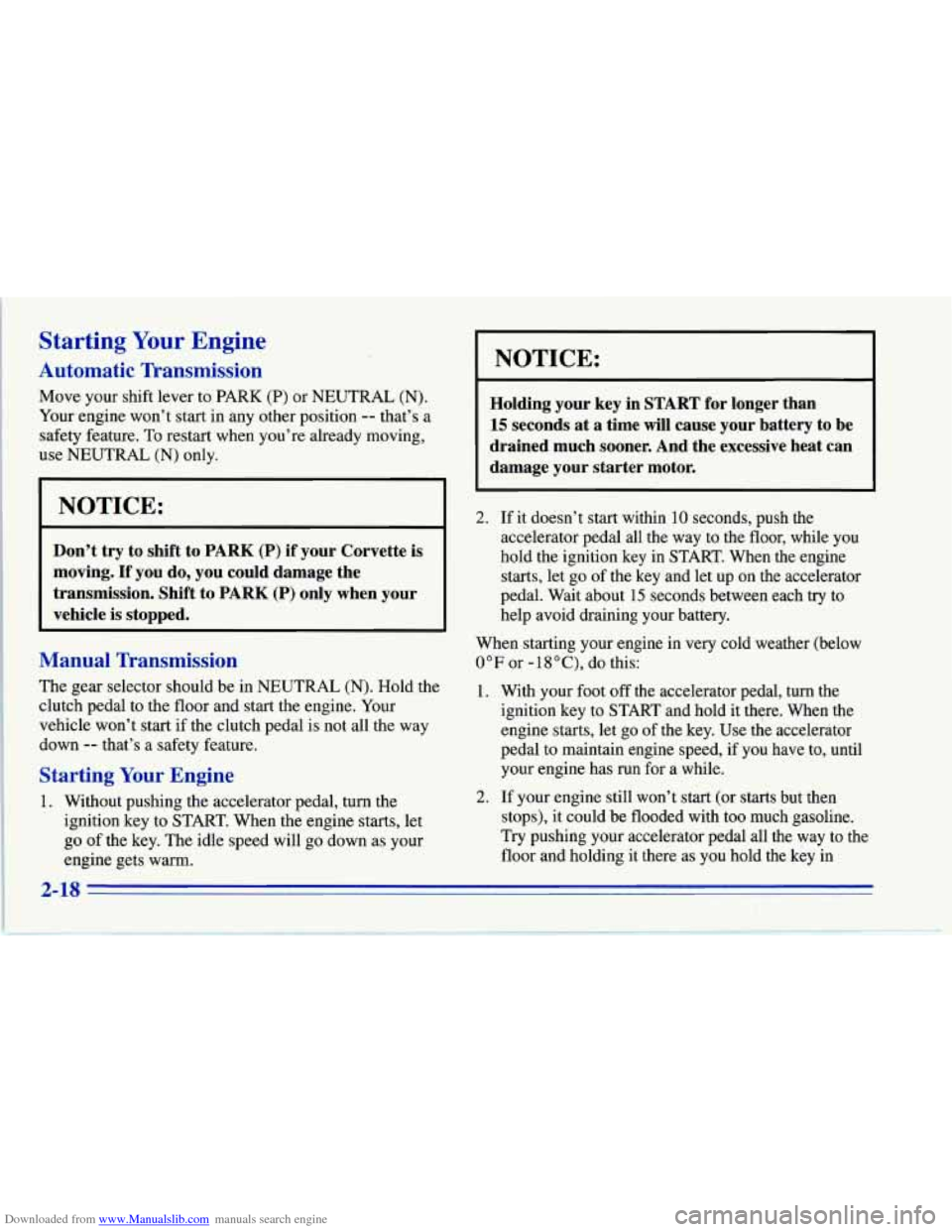
Downloaded from www.Manualslib.com manuals search engine Starting Your Engine
Automatic Transmission
Move your shift lever to PARK (P) or NEUTRAL (N).
Your engine won’t start in any other position
-- that’s a
safety feature. To restart when you’re already moving,
use NEUTRAL (N) only.
NOTICE:
Don’t try to shift to PARK (P) if your Corvette is
moving. If you do, you could damage the
transmission. Shift to PARK
(P) only when your
vehicle is stopped.
Manual Transmission
The gear selector should be in NEUTRAL. (N). Hold the
clutch pedal to
the floor and start the engine. Your
vehicle won’t start if the clutch pedal is not all the way
down
-- that’s a safety feature.
Starting Your Engine
1. Without pushing the accelerator pedal, turn the
ignition key to START. When the engine starts, let
go of the key. The idle speed will go down as your
engine gets warm.
NOTICE:
Holding your key in START for longer than
15 seconds at a time will cause your battery to be
drained much sooner. And the excessive heat can
damage your starter motor.
2. If it doesn’t start within 10 seconds, push the
accelerator pedal all the way to the floor, while you
hold the ignition key in START. When the engine
starts, let
go of the key and let up on the accelerator
pedal. Wait about
15 seconds between each try to
help avoid draining your battery.
When starting your engine in very cold weather (below
0°F or -18”C), do this:
1. With your foot
off the accelerator pedal, turn the
ignition key to START and hold it there. When the
engine starts, let
go of the key. Use the accelerator
pedal to maintain engine speed, if you have to, until
your engine has run for a while.
stops), it could be flooded with too much gasoline.
Try pushing your accelerator pedal all the way to the
floor and holding it there as you hold the key in
2. If your engine still won’t start (or starts but then
2-18
Page 62 of 386

Downloaded from www.Manualslib.com manuals search engine START for about three seconds. If the vehicle starts
briefly but then stops again, do the same thing, but
this time keep the pedal down for five or six seconds.
This clears the extra gasoline from the engine.
I NOTICE:
Your engine is designed to work with the
electronics in your vehicle.
If you add electrical
parts or accessories, you could change the
way
the engine operates. Before adding electrical
equipment, check with your dealer.
If you don’t,
your engine might not perform properly.
If you ever have to have your vehicle towed, see
the part of this manual that tells how to do it
without damaging your vehicle. See “Towing
Your Vehicle” in the Index.
Racing or Other Competitive Driving
See your Warranty Book before using your Corvette for
racing or other competitive driving.
NOTICE:
If you use your Corvette for racing or other
competitive driving, your engine may use more
oil than it would with normal use. Low oil levels
can damage the engine. Be sure to check the oil
level often during racing or other competitive
driving and keep the level at or near the upper
mark on the engine oil dipstick.
You may need to
add oil. See “Engine Oil” in the Index.
2-19
Page 65 of 386
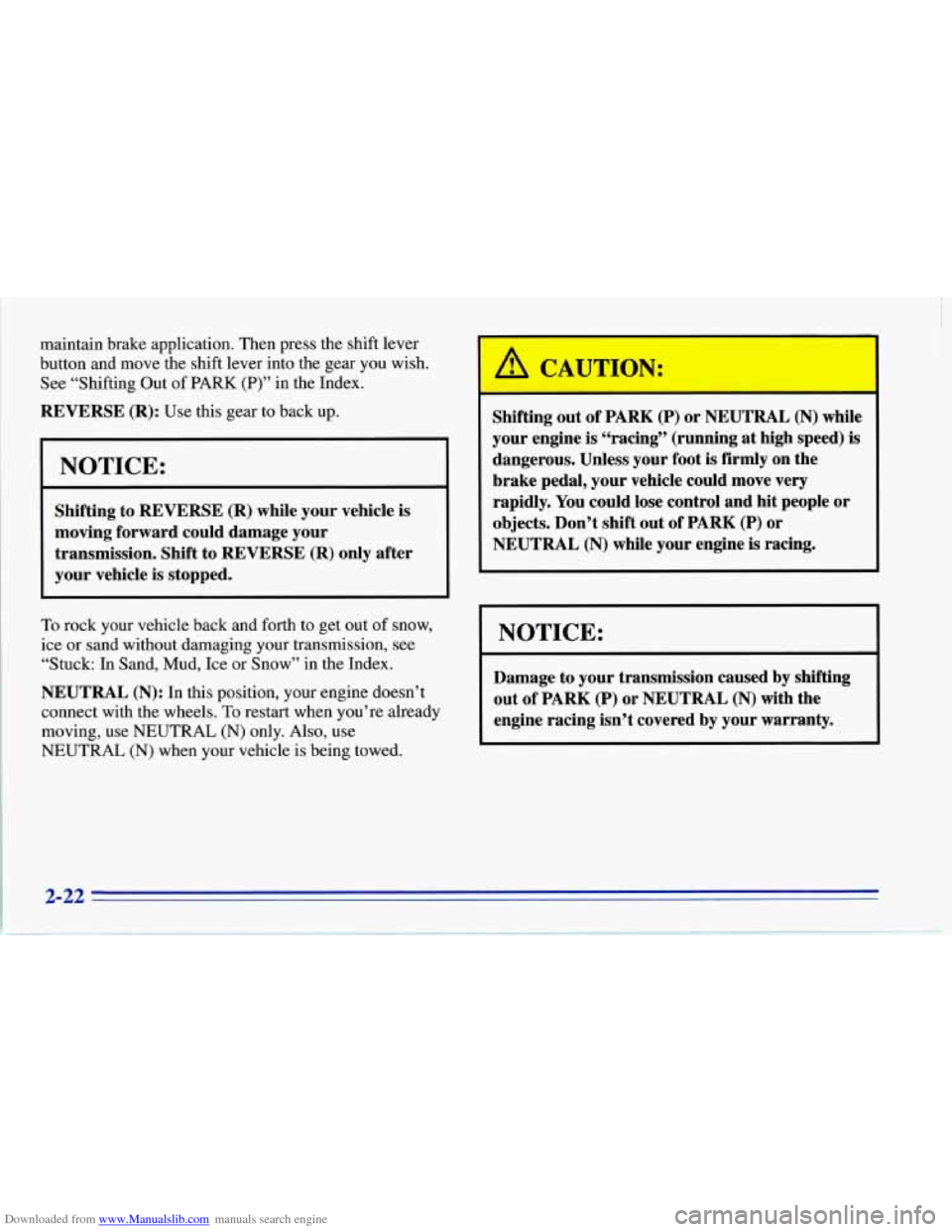
Downloaded from www.Manualslib.com manuals search engine maintain brake application. Then press the shift lever
button and move the shift lever into the gear you wish.
See “Shifting Out
of PARK (P)” in the Index.
REVERSE (R): Use this gear to back up.
NOTICE:
Shifting to REVERSE (R) while your vehicle is
moving forward could damage your
transmission. Shift to REVERSE (R) only after
your vehicle
is stopped.
To rock your vehicle back and forth to get out of snow,
ice or sand without damaging your transmission, see
“Stuck:
In Sand, Mud, Ice or Snow” in the Index.
NEUTRAL (N): In this position, your engine doesn’t
connect with the wheels.
To restart when you’re already
moving, use NEUTRAL
(N) only. Also, use
NEUTRAL (N) when your vehicle is being towed.
Shifting out’of PARK (P) or NEUTRAL (N) while
your engine
is “racing” (running at high speed) is
dangerous. Unless your foot is firmly on the
brake pedal, your vehicle could move very
rapidly. You could lose control and hit people or
objects. Don’t shift out of PARK
(P) or
NEUTRAL
(N) while your engine is racing.
I NOTICE:
I
~~~ ~
Damage to your transmission caused by shifting
out of PARK
(P) or NEUTRAL (N) with the
engine racing isn’t covered
by your warranty.
Page 67 of 386
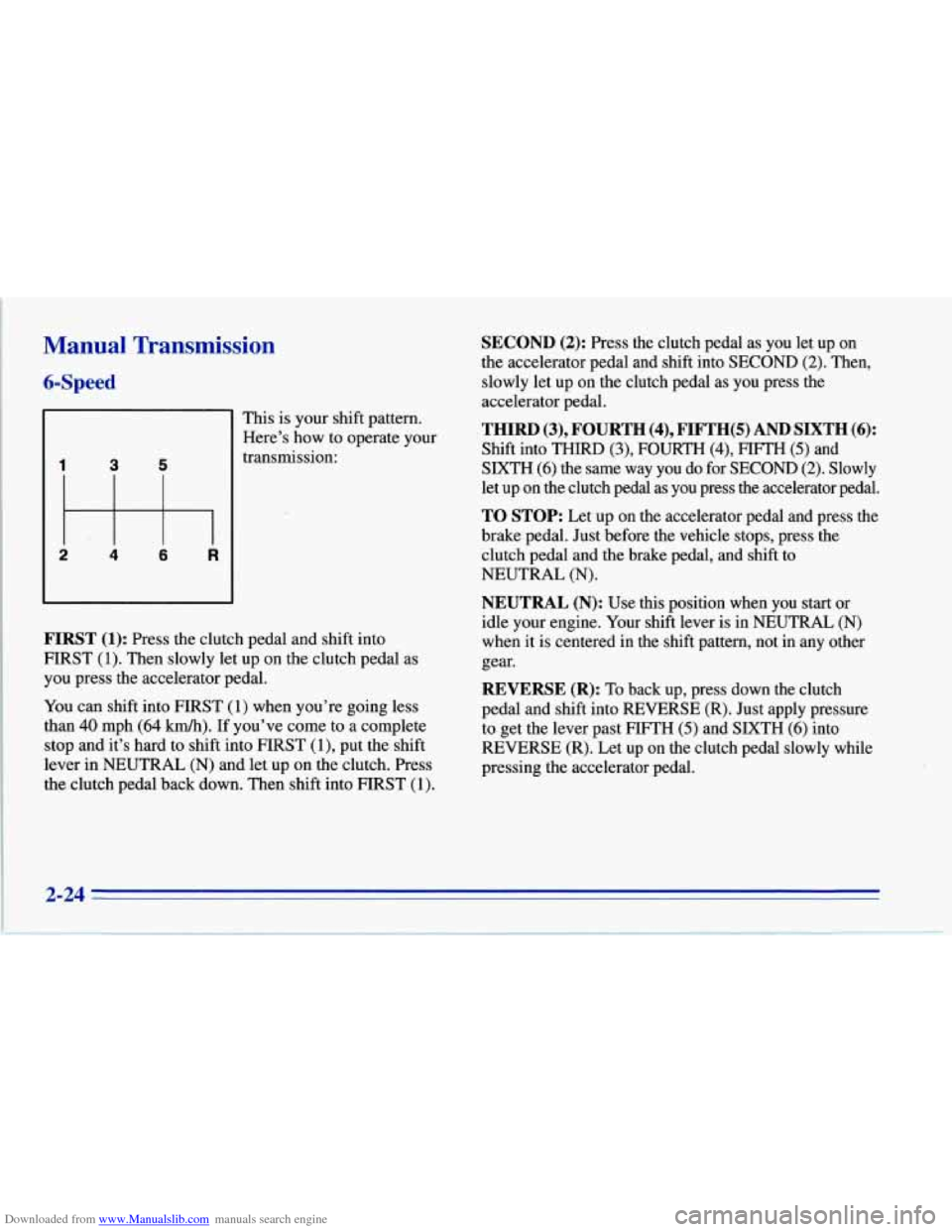
Downloaded from www.Manualslib.com manuals search engine Manual Transmission
6-Speed
This is your shift pattern.
Here’s how to operate your
transmission:
5 3
FIRST (1): Press the clutch pedal and shift into
FIRST (1). Then slowly let up on the clutch pedal as
you press the accelerator pedal.
You can shift into FIRST
(1) when you’re going less
than
40 mph (64 km/h). If you’ve come to a complete
stop and it’s hard to shift into HRST
(I), put the shift
lever in NEUTRAL (N) and let up on the clutch. Press
the clutch pedal back down. Then shift into FIRST (1).
SECOND (2): Press the clutch pedal as you let up on
the accelerator pedal and shift into
SECOND (2). Then,
slowly let up on the clutch pedal as you press the
accelerator pedal.
THIRD(3),FOURTH(4),FIFTH(S)ANDSIXTH(6):
Shift into THIRD (3)’ FOURTH (4), F’IFTH (5) and
SIXTH (6) the same way you do for SECOND (2). Slowly
let up on the clutch pedal as you press the accelerator pedal.
TO STOP: Let up on the accelerator pedal and press the
brake pedal. Just before the vehicle stops, press the
clutch pedal and the brake pedal, and shift to
NEUTRAL
(N).
NEUTRAL (N): Use this position when you start or
idle your engine. Your shift lever is in NEUTRAL (N)
when it is centered in the shift pattern, not in any other
gear.
REVERSE (R): To back up, press down the clutch
pedal and shift into REVERSE (R). Just apply pressure
to get the lever past FIFTH
(5) and SIXTH (6) into
REVERSE
(R). Let up on the clutch pedal slowly while
pressing the accelerator pedal.
2-24
Page 80 of 386
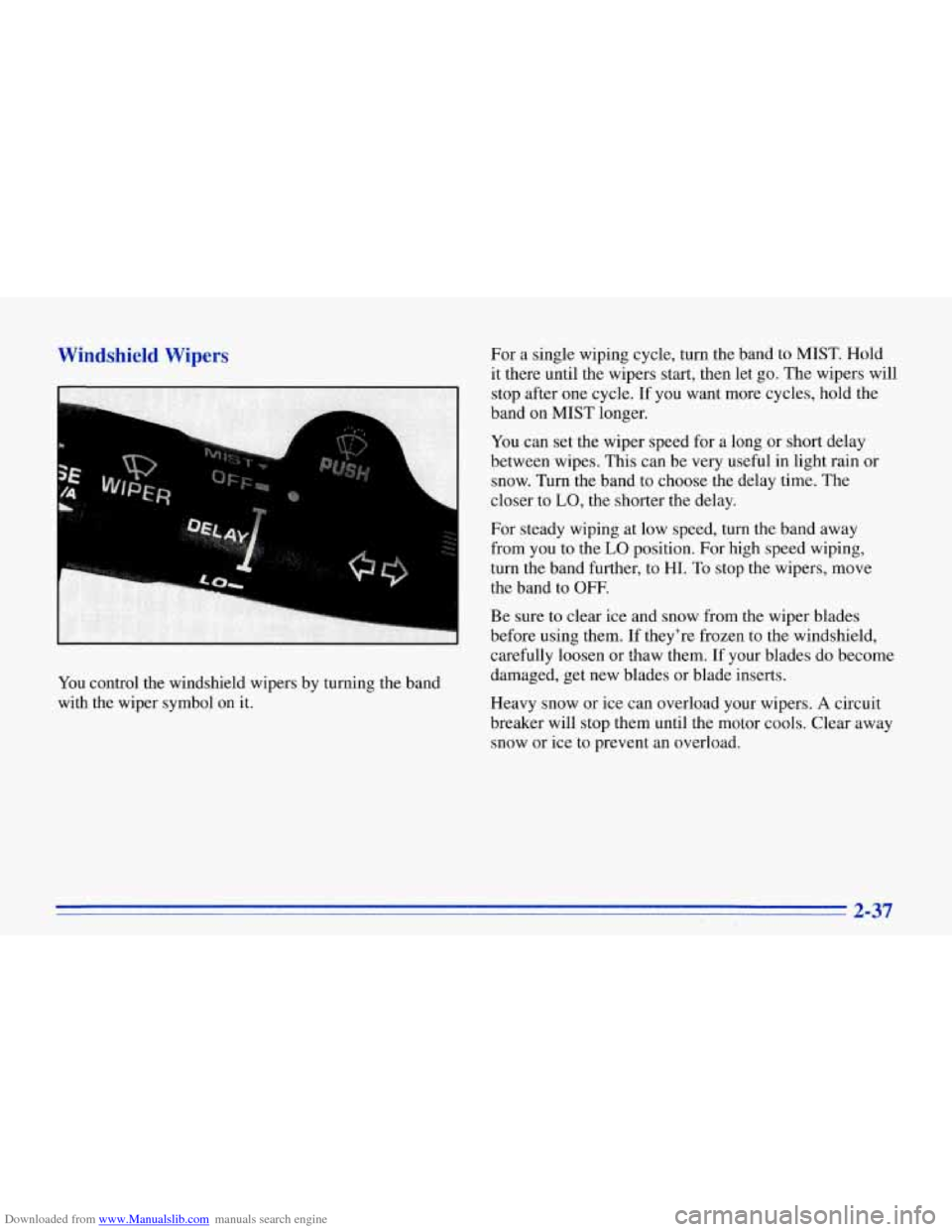
Downloaded from www.Manualslib.com manuals search engine Windshield Wipers
You control the windshield wipers by turning the band
with the wiper symbol
on it. For
a single wiping cycle, turn the band to MIST. Hold
it there until the wipers start, then let go. The wipers will
stop after one cycle. If you want more cycles, hold the
band on MIST longer.
You can set the wiper speed for a long or short delay
between wipes. This can be very useful in light rain or
snow. Turn the band to choose the delay time. The
closer to
LO, the shorter the delay.
For steady wiping at low speed, turn the band away
from you to the
LO position. For high speed wiping,
turn the band further, to
HI. To stop the wipers, move
the band to OFF.
Be sure to clear ice and snow from the wiper blades
before using them. If they're frozen to the windshield,
carefully loosen or thaw them. If your blades do become
damaged, get new blades or blade inserts.
Heavy snow or ice can overload your wipers. A circuit
breaker will stop them until the motor cools. Clear away
snow or ice to prevent an overload.
2-37